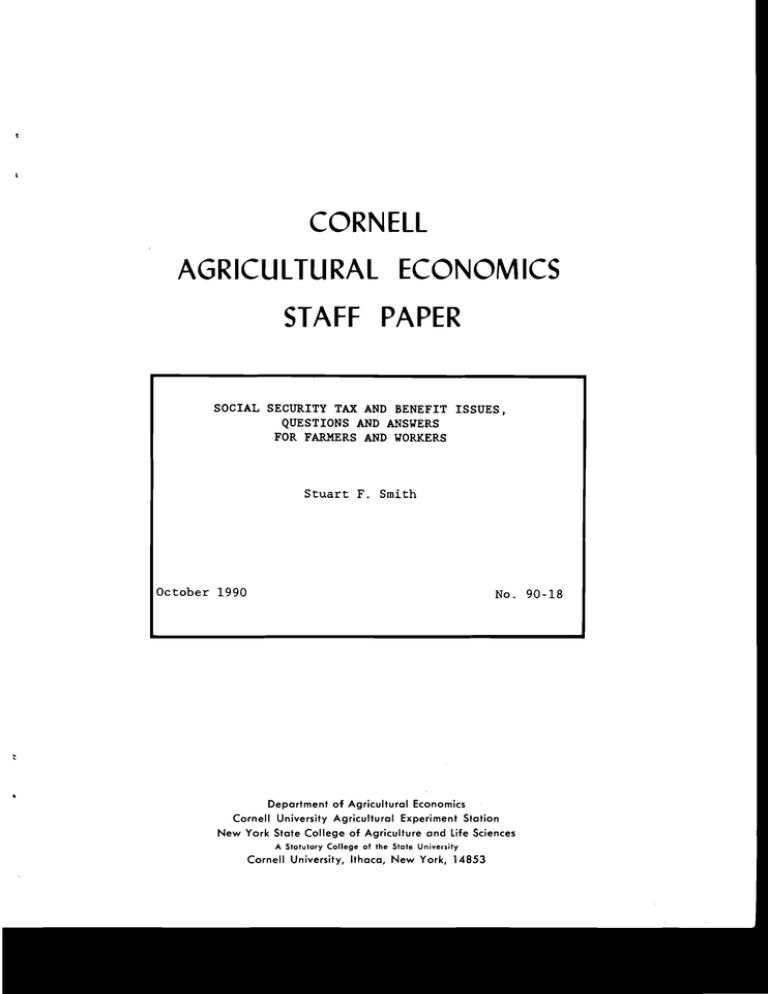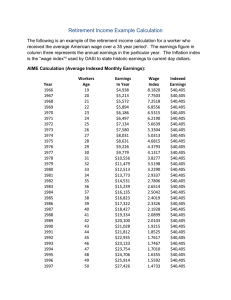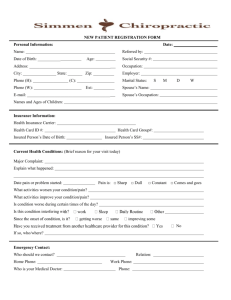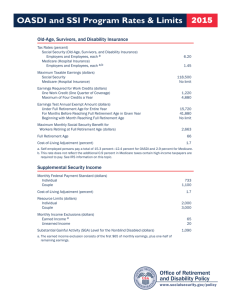Document 10280677
advertisement

CORNELL
AGRICULTURAL ECONOMICS
STAFF PAPER
SOCIAL SECURITY TAX AND BENEFIT ISSUES,
QUESTIONS AND ANSYERS
FOR FARMERS AND YORKERS
Stuart F. Smith
October 1990
No. 90-18
Department of Agricultural Economics
Cornell University Agricultural Experiment Station
New York State College of Agriculture and Life Sciences
A Stotutory College of the Stote University
Cornell University, Ithaca, New York, 14853
It is the policy of Cornell University actively to support equality
of educational and employment opportunity. No person shall be
denied admission to any educational program or activity or be
denied employment on the basis of any legally prohibited dis­
crimination involving, but not limited to, such factors as race,
color, creed, religion, national or ethnic origin, sex, age or
handicap. The University is committed to the maintenance of
affirmative action programs which wili assure the continuation
of such equality of opportunity.
ABSTRACT
Social Security taxes are a major and growing expense of
operating a farm business. Self-employed farmers and family farm
workers have some flexibility in managing cash income subject to
Social Security. A basic understanding of Social Security benefits
as well as costs is required to make a rational decision about
optimum coverage.
SOCIAL SECURITY - WHAT FARM FAMILIES NEED TO KNOW
Many farm families have some choices about distribution of income
which will affect taxes paid and thus benefits received in the
event of severe disability, death or retirement. Often these
choices are made only with the objective of paying the least
possible FICA and self-employment tax. Farm families should also
consider which family members should be and are eligible to receive
benefits and how the distribution of income affects the amount of
benefits.
For example, during transfer of farm ownership from the older to
the younger generation, interest, principal, rent and wage payments
are often made to members of the older generation. Often some
break is given on one or more of these payments in order to
successfully accomplish the transfer. If it is labor that is
discounted in value, FICA taxes will be saved, but that may result
in future retirement benefits being lower than as if full value was
paid for the work done.
Disability
A farm couple with young children should seriously consider
qualifying both parents for Social Security disability benefits.
If either parent is disabled, the cost to replace the farmwork,
house work, and/or child care plus care for the disabled person can
be devastating. If both spouses work only on the farm and the
business is organized as a sole proprietorship owned by one spouse,
it will be necessary to pay the other spouse at least $2,080 in
1990 (increases each year) for work on the farm for a full year's
credit toward Social Security coverage. If net farm profits are
very low or negative, an optional method of figuring net earnings
may be used by the farm operator to get a full year's credit toward
coverage.
The number of quarters of work credits needed for disability
benefits depends on your age, and when you become disabled. If you
are age 24 through 31, you need credit for having worked half the
time between 21 and the time you become disabled. In other words,
if you are disabled at age 31, you need 20 quarters or five years
of coverage. If disabled after age 31, you need five years of
credit out of the most recent 10 year period. You also need to
have as many total work credits as you would need for retirement.
The amount of disability benefit depends on the workers' earnings
record and composition of family. Also, medicare coverage is
available to people who have been entitled to disability benefits
for 24 months.
2
Survivors Benefits
Monthly benefits can be paid to various members of your family
should you die while currently insured by Social Security. To be
currently insured you must have six quarters of coverage during the
l3-quarter period ending with death. For example, the estimated
monthly payment in 1990 for the family of a deceased worker whose
earnings subject to Social Security averaged $10,000 during his
base period was approximately $1,000 per month. His family
included a widow and two children under age 16. For more
information on Survivors Benefits, contact the S.S.A.
Retirement
Retirement benefits are not based just on your last three or five
years of earnings as many farmers seem to believe. The formula for
computing Social Security retirement benefits is quite complex.
Ask your Social Security office for SSA Pub. 05-10070 which
provides a more complete description on how benefits are
calculated.
Step 1. The number of years to be used in calculating average
earnings is determined. Individuals reaching age 65 in
1990 will use 31 years of earnings. Those reaching 65 in
1991 will use 32 years. Persons born in 1929 or later will
use 35 years of earnings in their averaging.
Step 2. Earnings prior to age 60 are adjusted for inflation.
Earnings after 60 are used as is. The highest earning
years are used when the total number of earning years are
greater than the number of years required for averaging.
Years in which there are no earnings are added in as
zeroes.
Step 3. The earnings are then averaged. The average is divided by
12 to determine an "averaged indexed monthly earnings"
(AIME).
Step 4. The benefit formula is then applied to the AIME.
In 1990 the formula is: 90 percent of the first $356 of AIME, 32
percent of the next $1,790, and 15 percent of any amount over
$2,145 of AIME. For example, a p~rson with AIME of $2,000 would
receive:
$356 x .90
$320.40
$1,644 x .32
526.08
$0 x .15
o
Total of $846.48 (without cost of living adjustment)
Step 5. The basic benefit is adjusted for early or later
retirement (if appropriate). If a person retires at 65, the
preliminary benefit is adjusted by "cost-of-living" after 62.
The benefit for your wife or husband at 65 is one-half of your 65
benefit. If you arc primarily interested in receiving an estimate
of your Social Security retirement benefits rather than how they
3
are calculated, ask your Social Security office for a Request for
Earnings and Benefit Estimate Statement, Form SSA-7004-PC-OPI. If
you are nearing retirement and can accurately estimate future
earnings, filling out and sending in this form will provide you
with a free statement of your earnings covered by Social Security
and your estimated future benefits.
Trying to raise retirement benefits by increasing earnings during
the last years before retirement is not very effective because AIME
is based on so many years. Also, if your AIME is already more than
$2,145, an increase of $100 AIME would mean only $15 more
retirement benefit per month. However, if AIME is under $356,
increasing it would result in significantly higher retirement
benefits.
Social Security is designed to replace part of the income you and
your family lose when you retire, become severely disabled, or die.
Many people need additional retirement income, disability
insurance, and life insurance during some stages of their lives.
Increases in Social Security (FICA) and self-employment rates, and
increases in earnings subject to the tax have placed a higher
priority on exploring opportunities to reduce the burden of these
taxes. Farmers now pay at a rate of 15.3 percent on the first
$51,300 of earnings subject to Social Security. The net farm
profit from the bottom of Schedule F or self-employment income is
reduced by 7.65 percent in calculating earnings subject to Social
Security. In addition, self-employed taxpayers may take a
deduction from taxable income for one-half the Social Security
taxes paid on self-employment.
In summary, you need to know where you stand now before deciding
whether it is to your advantage or disadvantage to try to lower
taxes paid. Tax dollars saved and invested for the future could
for some persons, result in higher income during retirement. Tax
dollars kept from IRS but spent now could mean lower income during
retirement.
Prepared by Carl A. Crispell, Regional Farm Management Specialist
Revised October 1990
Stuart F. Smith, Senior Extension Associate, Cornell Cooperative
Extension
4
QUESTIONS AND ANSWERS ABOUT SOCIAL SECURITY
1. Who is eligible to receive Social Security benefits?
answer: Benefits are granted to those that are insured.
are the four different categories of insured status:
Here
A.
Currently insured -- provides limited survivor benefits;
requires six quarters of coverage in last 13 quarters for
period ending with disability, retirement or death.
B.
Fully insured -- provides retirement and survivor benefits;
requires 40 quarters of coverage since 1950 or age 21 if
later, in 1991 (39 in 1990).
C.
Disability insured
provides disability in addition to
retirement and survivor benefits; must be fully insured
plus 20 quarters of coverage in last 10 years, or one-half
the quarters (minimum of six) after reaching age 21 if
disabled before reaching age 31. Disability benefits are
also paid to a qualified spouse and dependent children.
D.
Transitiona11y insured -- provides some benefits for those
reaching age 72 that have too few quarters to qualify as
fully insured.
In summary, retirement and disability benefits are paid to
insured workers, dependents of retired or disabled workers and
surviving family members of deceased workers.
2. What coverage is needed to enable the dependent or surviving
spouse to receive survivor benefits?
answer: A widow or widower caring for a dependent child under
age 16 or disabled, is eligible for survivor benefits if the
worker is currently or fully insured. If there are no
dependent children, the surviving spouse must be age 60 or over
and the worker must be fully insured. Dependent, unmarried
children under age 18 or full-time students receive survivor
benefits when the deceased is currently or fully insured.
3.
How much must be earned to receive one quarter of coverage?
answer: In 1990 annual earnings divided by $520 equal the
number of quarters (up to four) earned by an individual this
year. The dollar amount needed to equal one quarter has
increased annually from $250 in 1978. A self-employed person
needs at least $400 in annual net earnings to be credited with
any quarters of coverage for that year. Different coverage
rules and amounts were in effect before 1978. In general, one
quarter was credited when $100 or more was earned in a calendar
quarter.
5
4.
How are retirement benefits computed?
answer: Most Social Security benefits are based on the insured
individual's primary insurance amount (PIA) which is currently
based on the average indexed monthly earnings (AIME). PIA is
equivalent to the basic monthly benefit computed by a formula
that is tied to changes in cost of living and changes in
national wage rates. AIME represents the insured individual's
average monthly earnings over most of his or her working
career, indexed for inflation. Computing AIME involves
counting the worker's elapsed years. determining base years and
selecting benefit computation years.
5.
What are elapsed years, base years, and computation years?
answer: Elapsed years are the number of calendar years after
1950 up to but not including the year the worker reaches age
62. If the worker was age 20 or less in 1950, start with the
year after reaching age 21.
Base years are the years after 1950 up to but not including the
year the worker becomes eligible for full benefits (age 65) or
through the year following the worker's death, whichever is
shorter.
Benefit computation years are the base years with the highest
earnings. In most cases the number of elapsed years minus five
are the number of computation years to use.
Example:
Mac A. was 65 in August 1990. He applied and became
eligible for retirement benefits. Since he reached age 62
in 1987 he has 36 elapsed years (1951 through 1986). His
base years begin with 1951 and end with 1989, a 39 year
period. His benefit computation years are the 31 (36-5)
highest earning years from the base year period. Mac can
eliminate the eight lowest earning years from his 39 base
year period.
6.
Can I calculate my AIME and PIA?
answer: It is possible but not easy. You would have to know
how to index most of your prior years' earnings to reflect the
increase in average U.S. wages to compute your AIME. The
formula used to compute PIA changes each year. For workers
eligible for benefits in 1990, PIA equals:
90% of the first $356 or less of AIME
+32% of AIME between $356 and $2,146
+15% of AIME $2,146 and above
Rounding procedures used by the Social Security administration
and cost of living adjustments make it difficult to duplicate
official PIA's. It is best to have Social Security calculate
your AIME, PIA, and estimate benefits for you! Ask for Form
SSA-7004-7004-PC-OPI.
....
6
7.
What are the maximum retirement benefits?
answer: In 1990 they are $975.00 per month for a fully insured
individual retiring at age 65. Reduced benefits (approximately
80 percent of full) are available at age 62. In addition, the
retiree's spouse may be eligible for benefits.
8.
What are the retiree's spouse's benefits?
answer: When a worker or fully insured individual retires at
65, his or her spouse age 65 or more may receive 50 percent of
benefits. If the spouse is age 62, he or she is eligible for
37.5 percent of the insured spouse's benefits. The spouse of
an insured retiree cannot draw Social Security benefits from
his or her own earnings plus those of the retired spouse. A
spouse caring for the retired worker's child is eligible to
draw if less than age 62. Use the Sample Benefits table at the
end of this publication to find the relationship.
9.
What are the benefits paid to a surviving spouse?
answer: Full benefits, if the deceased was fully insured.
Qualifications vary if the surviving spouse is caring for a
child and if the spouse remarries. Reduced benefits may be
drawn at age 60. A surviving spouse caring for a child will
receive benefits if the deceased was currently or fully
insured. The dependent child is also eligible.
10. How much are disability payments?
answer: Disability payments are equal to the retirement benefit
that would be paid at normal retirement age or the worker's
PIA. Dependent children are eligible for 50 percent benefits.
11. Are there maximum benefits a family may draw?
answer: Yes, there is a cap on total family benefits. It is
computed using 85 percent of the worker's average wages or 150
percent of the PIA. Total family benefits include workers
compensation insurance and other federal and state disability
payments. Refer to the Sample Benefits table attached to see
the relationship between AIME , PIA, and maximum family
benefits.
12. Will retirement age remain at age 65?
answer: Normal retirement age is scheduled to increase to age
67 after the turn of the century. It will be phased in
starting in the year 2000 with an addition of two months per
year for six years for individuals reaching age 62. For
example, normal retirement age will be 66 for those reaching 62
in 2005. A second six year phase-in starts in the year 2017.
Early retirement benefits will be reduced to 75 and 70 percent
of full benefits when normal retirement age reaches 66 and 67
respectively.
7
Sample Benefits for Worker Reaching Age 65 in 1990
AIMEl
$
PIA2
Spouse
Age 65
Age 62
100
200
300
400
500
$101. 90
204.10
306.20
349.10
385.40
$ 50.90 $ 38.10
102.00
76.50
153.10 114.80
174.50 130.80
192.70 144.50
600
700
800
900
1,000
421.70
458.00
494.30
530.60
566.90
210.80
229.00
247.10
265.30
283.40
1,100
1,200
1,300
1,400
1,500
603.20
639.50
675.90
712.10
748.60
1,600
1,700
1,800
1,900
2,000
2,100
2,200
2,300
2,417 3
Survivors
Spouse 62
Child
Maximwn
per Family
153.00
306.00
459.40
523.70
578.20
$ 84.40
169.10
253.80
289.40
319.40
$ 76.40
153.00
229.60
261. 80
289.00
158.10
171.70
185.30
198.90
212.50
349.50
379.60
409.70
439.80
469.90
316.20
343.50
370.70
397.90
425.10
632.70
697.90
796.50
895.20
994.20
301. 60
319.70
337.90
356.00
374.30
226.20
239.70
253.40
267.00
280.70
500.00
530.10
560.30
590.30
620.50
452.40
479.60
506.90
534.00
561.40
1,092.80
1,191.60
1,251.50
1,300.20
1,348.80
784.80
821. 00
857.40
887.10
904.10
392 .40
410.50
428.70
443.50
452.00
294.30
307.80
321.50
332.60
339.00
650.50
680.60
710.70
735.40
749.40
588.60
615.70
643.00
665.30
678.00
1,397.50
1,446.20
1,499.90
1,551.90
1,581. 70
921. 20
938.20
955.10
975.00
460.60
469.10
477.50
487.50
345.40
351. 80
358.10
365.60
763.60
777.70
791.70
808.20
690.90
703.60
716.30
731. 20
1,611.50
1,641.70
1,671.0(')
1,705.70
$
lAveraged Indexed Monthly Earnings.
2primary Insurance Amount. Monthly benefits for fully insured
workers age 65, subject to rounding. Disability benefit usually
same.
3Maximwn for most workers reaching age 65 in 1990.
Source: 1990 Social Security Explained, Commerce Clearing
House, Inc.
.'
8
LETTERS FROM FARMERS
Dear Tax Advisor:
I am a 60 year old self-employed farmer, my wife is 61. I am
going to retire at age 65 and sell the farm. I have received my
Earnings and Benefit Estimate from Social Security. They say my
estimated retirement benefits are only $400 per month because I had
several years of zero earnings from 1951 to 1965. I have estimated
my average earnings for the next four years at $15,000 but can
raise it to $20,000 if added Social Security benefits would make it
pay. Please advise.
Sincerely,
H.H. Atlast
Dear Atlast:
Increasing your future earnings by $5,000 per year for the
next four years will add approximately $571 to your 35 year annual
average earnings and about $48 to your AIME. This will increase
your retirement benefits approximately $15 per month. If your wife
is eligible to receive spousal benefits your combined benefits will
increase approximately $22.50 per month.
Additional Social Security taxes will cost you at least $650
per year or $2,600 ($2,060 present value at 10 percent). You may
have additional income taxes as well. You and your wife must draw
benefits for 10 or more years before you break even with Social
Security taxes in present value terms. If you and your wife live
beyond age 80, the added Social Security benefits may exceed what
you paid for them.
~
My advice: manage your business over the next four years to
maximize after-tax profits rather than to increase Social Security
benefits.
Sincerely,
Tax Advisor
Dear Farm Tax Specialist:
Hy husband and I own and operate a small farm business. We
have four dependent children, pay little income tax, but my
husband's self-employment income may exceed $20,000 in 1990. We
are 28 years old and have operated the farm for three years. I
paid Social Security taxes for eight years prior to 1988. Hy
husband has been covered since 1983. Should I renew my Social
Security insurance coverage by taking a wage for the work and
responsibilities I have in this business?
Sincerely,
Liberated Farmer's Wife
~
­
9
Dear Liberated:
If you die or are disabled it may be a major financial loss
to the family and business. Becoming insured for disability
benefits may help. To be disability insured, you will need Social
Security coverage for at least one-half the quarters beginning with
the quarter after your 21st birthday, and ending with the quarter
before your 31st birthday or the quarter in which you become
disabled. If you were 21 years old during the first quarter of
1983, you may have 19 quarters of coverage which is more than one­
half of the 31 quarters that have passed to-date. If you continue
with no coverage for six more quarters, you will lose disability
insurance coverage. Drawing a wage as an employee of the business
and paying 15.3 percent Social Security tax may be worth more than
the cost.
Your potential disability benefits depend on your primary
insurance amount (PIA) which is based on your AIME. If your annual
earnings averaged $15,000 from 1983 through 1987, your AIME will be
more than $1,250 per month and your PIA would exceed $650 per
month. Since your dependent children are also eligible to receive
one-half of the PIA, your family would be eligible for maximum
benefits that could exceed $1,200 per month. Part-time farm
employment may reduce your PIA in future years.
You will need to take $2,080 in 1990 farm wages to earn four
quarters of additional coverage. This minimum will increase in
1991.
The cost of you taking a wage from the farm business will be
the potential loss of future Social Security benefits to your self­
employed husband. There should be no or very little difference in
the total Social Security taxes paid by you and your husband. The
potential loss of your husband's future benefits is small if his
average indexed monthly earnings (AIME) are maintained at
approximately $360. This AIME is equivalent to $4,320 of net farm
profit from Schedule F.
Sincerely,
Farm Tax Specialist
...
,­
Other Agricultural Economics Staff Papers
No. 90-6
Tax Policy and Business Fixed Investment
During the Reagan Era
C. w. Bischoff
E. C. Kokkelenberg
R. A. Terregrossa
No. 90-7
The Effect of Technology on the U.S. Grain
Sector
O. D. Forker
No. 90-8
Changes in Farm Size and Structure in
American Agriculture in the Twentieth Century
B. F. Stanton
No. 90-9
Optimal Agricultural Policy with Biotechnology:
Bovine Somatotropin and the Dairy Sector
L. W. Tauer
H. M. Kaiser
No. 90-10
How Diversified is Your State's Agriculture?
L. W. Tauer
No. 90-11
Bovine Somatotropin and Milk Production:
Potential Impacts for the U.S.
H. M. Kaiser
No. 90-12
The Potential for Structural Change in the
Northeast Dairy Manufacturing Sector
M. W. Stephenson
A. M. Novakovic
J. E. Pratt
No. 90-13
Disaster Planning in the Dairy Industry:
Conceptual Issues and a Special Modelling
Approach
M. Keniston
J. Pratt
M. Stephenson
A. Novakovic
No. 90-14
Farm Financial Standards Task Force:
Progress and Recommendations
E. L. LaDue
No. 90-15
A Conceptual Framework for the Management
of Farm Businesses
R. A. Milligan
G. K. Hutt
No. 90-16
Modeling the U.S. Dairy Sector With
Government Intervention
Donald J. Liu
Harry M. Kaiser
Timothy D. Mount
Olan D. Forker
No. 90-17
Policy Education Programs for Extension's
Solid Waste Initiative
David Allee
-





